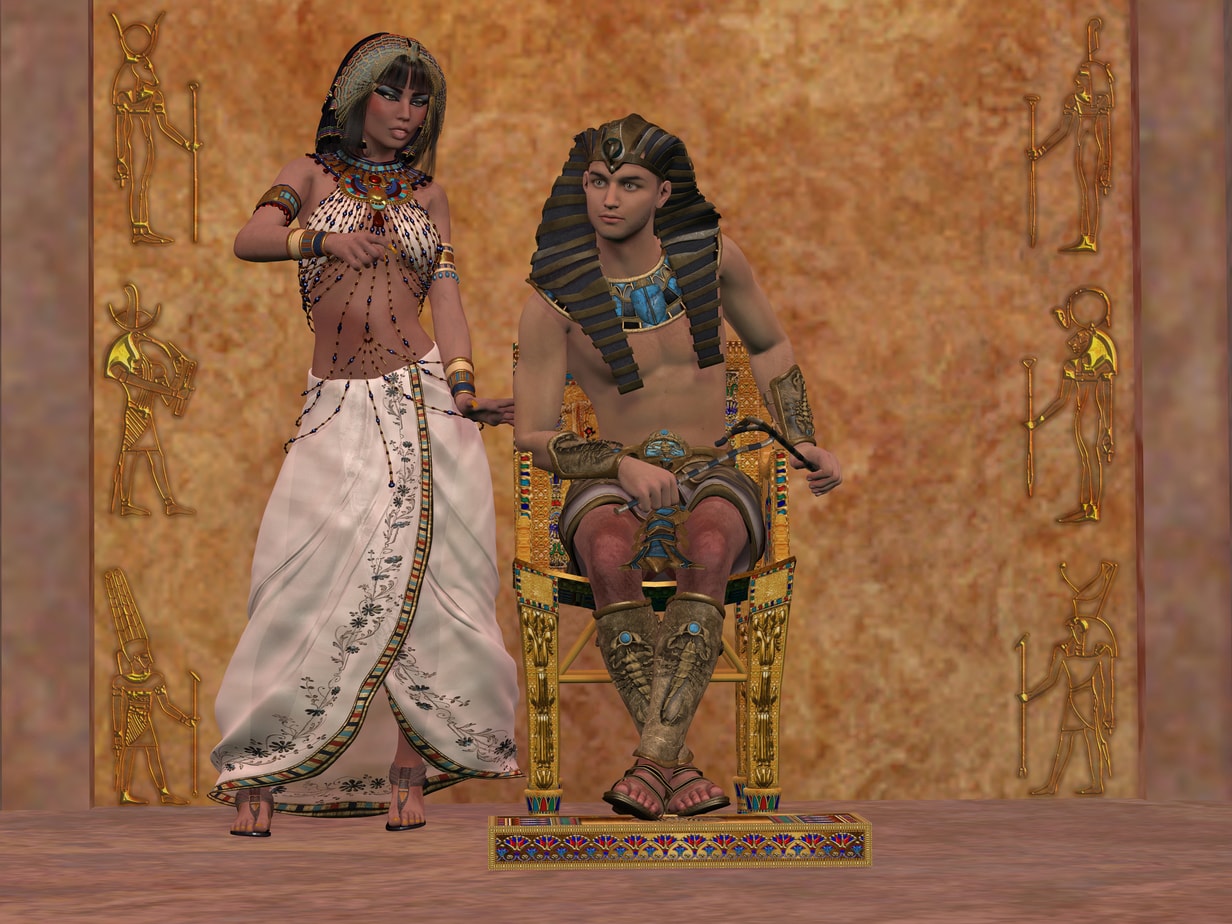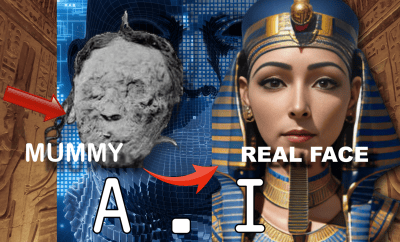Top 14 Egyptian Pharaohs Clothing: What They Mean as Halloween Costumes
Ancient Egyptian Clothes
Halloween costumes is maybe how many people get introduced to Ancient Egypt civilization nowadays, but how did Ancient Egyptian Pharaohs dress up back then? And how was clothing different from the commons? Ancient Egypt goes back more than 5000 years since first Hieroglyphics were discovered and maybe more than 7000 years even before writing started.
Clothes in Ancient Egypt have gone through more than 3500 years of evolution. What Pharaohs wore in 3000 BC for example was considered ancient for those Pharaohs who lived in 100 BC. Today Ancient Egyptian clothes inspire many of the modern fashion designs, Cosplay and Halloween costumes. So how did it all start? What did real Pharaohs wear? And what does those Ancient Egyptian costumes for sale today really mean?

Ancient Egyptian Clothing Facts
So, what did pharaohs wear? Clothes in Egypt reflected two main things: Desert climate and social status. Egyptian Society was divided into classes. Deity and Royals were the top class followed by the wealthy and highly ranked officials, then common people and farmers or workers, and finally slaves. Different pieces of clothes addressed these classes showing power, status, fashion, or wealth while also taking the hot weather into considerations. Here is a list of most popular Ancient Egypt clothing pieces:
- Kalasiris (or Calasiris)
- Shendyt (Egyptian kilt), or Schenti
- Pschent
- Egyptian Tunic
- Egyptian loincloth
- Uraeus
- Headdress: Deshret,
- Headdress: Khepresh,
- Headdress: Royal Vulture,
- Headdress: Nemes,
- Headdress: Modius,
- Headdress: Khat
- The Crook and Flail
- Kyphi
Pick a Costume for and Event or for Halloween
You can find here some of the best recommendations from Amazon for Ancient Egyptian costumes, but first if you would like to learn more abut what these costumes mean keep reading..
Kalasiris (or Calasiris)
![Ancient Egyptian Kalasiris (or Calasiris) Attribute:Metropolitan Museum of Art [CC0]](https://egyptianplanet.com/wp-content/uploads/2019/10/Estate_Figure_MET_DP249002-149x300.jpg)
Kalasiris (or calasiris as Herodotus called it in his book about Egypt) is a long dress worn by Egyptian women since Old Kingdom. It lasted all the way until the end of New Kingdom. It spanned from the ankles up to the torso or the breasts and had straps over the shoulder to hold it in place. It evolved over time to cover the breasts. Klarisis was the most common garment for Egyptian women. The most common color was white, but Egyptian women also wore in in different bright colors. It also evolved to be decorated with beads and patterns by the time of the New Kingdom. It was made of linen, but the quality varied between cheap and expensive version. Some expensive versions were so thin and soft they were almost transparent.
Shendyt (Egyptian kilt), or Schenti
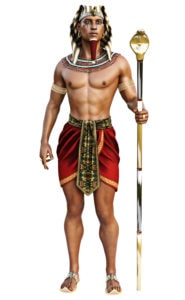
This is the Ancient Egyptian Kilt. It was worn by men and sometimes women since Old Kingdom. It was usually made of Linen in white color. It extended from the waist line to knee level.
Egyptian Postiche

Most Egyptians actually shaved their hair including facial hair. They wore fake beards called postiche. These beards were mostly worn by Pharaohs as a symbol of power, masculinity, and closeness to gods or being gods themselves. These fake beards were usually made of goat hair and looked to be relatively narrow and long. They were even depicted on dead Pharaohs coffins and statues.
Egyptian Tunic
This is long rectangular piece of fabric that was wrapped around the body and extended to waist line. Sometimes is was sewn at the side with a whole at the top for the head. Egyptians had also added wide sleeves to the tunic usually starched. It sometimes extended below the waist line and it was also worn with the Egyptian Kilt. It was tied in the front or held in place with a belt.
Egyptian Loincloth
![Ancient Egyptian Loincloth Tribute:Maler der Grabkammer des Kenamun [Public domain]](https://egyptianplanet.com/wp-content/uploads/2019/10/Maler_der_Grabkammer_des_Kenamun_001-247x300.jpg)
This is a poorer version of the Shendyt or Schenti (sometimes all these names are used interchangeably) or and underwear for some Ancient Egyptians. It was mainly worn by worker class. It was a rectangular or triangular piece of linen wrapped around the hips and gentiles.
What did Pharaohs Wear on Their Heads?
Many Egyptians men and women (but not all) shaved their heads and wore wigs for the looks and social status. Wigs evolved over time to eventually be decorated with plant based stripes, jewellery and Egyptian perfume cones.
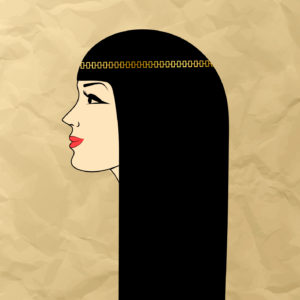
The Pharaohs wore different types of crowns and Egyptians also had specific types of crowns too.
Uraeus
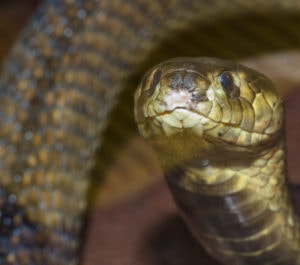
This is an upright form of an Egyptian cobra (spitting cobra or asp). It is a symbol of royalty, divine authority, or deity in Ancient Egypt. It shows power of the Pharaoh over his or her enemies.
Deshret
The red crown called Deshret represented Lower Egypt and white crown or Hedjet Crown represented upper or southern Egypt. The combination of both represented united Egypt and is called Pschent(or Pshent ) Crown.
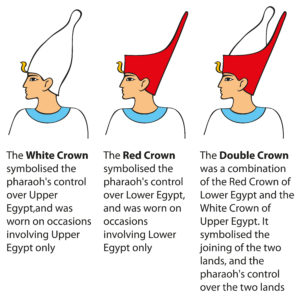
The Khepresh Crown
The Khepresh Crown was worn by Pharaohs in wore and had a Uraeus (a standing cobra) in the front symbolizing the power of the Pharaoh against the enemies and his protection by the gods.

Royal Vulture or Eagle Crown
A Royal Vulture or Eagle Crown was worn to show protection and had wings covering the sides. Seshed crown had a Uraeus attached to a metal headband.

The Nemes
The Nemes is striped head cloth worn by the pharaohs with decorative flap. It wa usually also decorated by a standing cobra (Uraeus).

The Modius Crown
The Modius was cylindrical crown with a flat top and was worn by goddesses or queens.
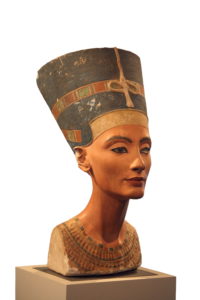
Khat (Headdress)
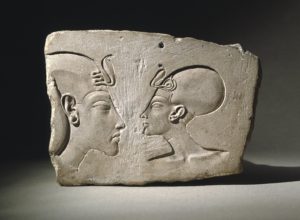
Khat or Afnet was made from from material like a kerchief. The Cap Crown had uraeus and decorated with circles and lines. With no pleats or stripes it was simpler than Nemes and was open on the back.
Crowns of Egyptian Gods
Egyptian Gods also had their crown. The The Shuti Crown is worn by the god Heryshaf and had ram horns and falcon feathers. Another version was worn by the god Amun and is called Double Plumed Crown. A four feathered crown is worn by the god Anhur.
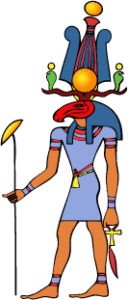


The Hemhem Crown was worn by Heka the god of magic and had ram horns, ostrich feathers, and a disc representing the sun. The cow horns crown was worn by the goddesses Hathor and Isis.
The Crook and Flail

The Flail is a symbol of fertility of the land. The crook (of shepherd) is a symbol of kingship. They were used as symbols by Pharaohs early on, but came together second dynasty of the Old Kingdom.
Kyphi

Kyphi (or Kapet in Egyptian Language) is Egyptian perfume. Ingredients are not exactly known. Some ingredients included: Honey,Frankincense (antiu), Mastic, Genen (Sweet Flag), Pine Kernels, Cyperus Grass, Camel Grass, Inuktun, Cinnamon, Raisins, Wine, Honey, Mint. Some recipes were never found, but there are 2 or 3 recipes that have been discovered.
Evolution of Egyptian Clothes Through 3000 Years
Ancient Egypt history is usually divided into three eras: Old kingdom (2700 to 2200 BC), Middle Kingdom (2050 to 1550), and new kingdom(1550 to 1070). Before the Old Kingdom there were early dynasties and before that the periods before Egypt was united as one country. After the New Kingdom, came the Ptolemaic and Roman eras. Real Egyptian Pharaonic clothing really evolved during the three eras I mentioned above.
Egypt Old Kingdom Clothes and Fashion
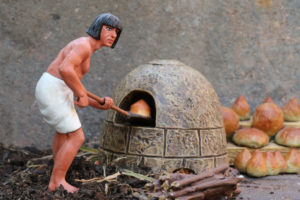
The Old Kingdom is famous for the grand pyramid structures including the Ancient World wonder that is still standing: The Giza Pyramids. You can read more about these grand monuments here. Both men and women wore kilts that called Shendyt. This is a knee or above knee high kind of dress strapped around the waist with a belt made of cloth, rope, or some other materials like papyrus.

Upper class and royalty wore the same clothes but with added ornamentation and jewelleries. However upper class women wore body long fitting dress with straps around the neck and shoulders. Lower class women wore skirts from the waist to above the knees,

Clothes made of linen evolved during this era, but before that people also uses animal hides or papyrus bases clothes. Workers, farmers, and slaves worked completely naked. Women hair was usually cut at ears level.
Egypt Middle Kingdom Clothes and Fashion

People continued to wear the Shendyt or kilt, but upper class men wore pleated kilts. Cotton made clothes became more popular among upper class. Triangular apron or kilt also became the norm among officials and government employees. It was starched and decorated.
Women hair was usually to the shoulders or even longer and started having different hair styles. Women wore form fitting long dresses with a necklace around the neck. A belt held it together at the waist for this one piece of cloth dress. Women also wore dress that covered the area from the ankles to the waist and wrapped around the shoulders with straps.
Egypt New Kingdom Clothes and Fashion

When Pharaoh Ahmose kicked out the Hyksos out of Egypt and reunited Egypt under one government, this triggered the beginning of the New Kingdom with long prosperous era. Clothes became more elaborate and Egypt’s interaction with other culture contributed to evolution in Egyptian fashions.
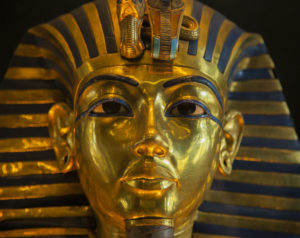
Decorated gowns with embroidery, beads, and jewellery became common among upper class. Wigs with jewels and beads also became popular. A caplet (a shawl) made of linen that was decorated and folded in different ways, was worn on top of calasiris (or kalasiris) was new addition in this era to the Egyptian clothing fashions.

The Shendyt or Egyptian kilt was still the norm among lower class but now women usually covered their upper body half. Servants wore pleated kilts or tunics and loincloth.
Underwear was sewn to waist size and made with higher quality and tied on the back. It was worn by upper-class and noble men under loincloth and a long shirt the extended to the knee level. They also wore necklaces and sandals.

Wigs were used by both men and women who in many cases shaved their heads to avoid hair maintenance and lice. Upper class women wore a cape or gown that is decorated or ornamented in addition to jewellery.
Priests wore white color robes as a symbol or purity. Soldiers, farmers and workers wore Shendyt or kilts. Egyptians wore wool jackets in cold weather, but these were not allowed in temples and sacred places as these animal based clothes were seen as impure throughout all Egyptian kingdoms.
Why are Egyptian Clothing Styles and Fashion Still Inspiring?
The Egyptian clothing style and fashion lived through the Ptolemaic era that came after the fall of the new kingdom. The Ptolemaic ‘Pharaohs’ embraced many of the Egyptian cultural heritage including clothing and fashion.
Egyptian clothing evolved across Ancient Egyptian Kingdoms, but it has maintained a concept over thousands of years: It was always practical, simple and elegant at the same time. It is still inspiring fashion designers today.
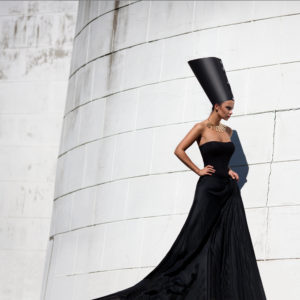
Many world famous fashion designers have used inspirations from Ancient Egyptian clothing including John Galliano, Christian Dior Haute Couture, and Fausto Puglisi, Elie Saab, and many others. Many Egyptian motifs and iconography are used in modern designs according to ION Magazine.

Many movies and Hollywood productions depicted Ancient Egypt inspired stories such as THE Egyptian. You can find a long list on IMDB.
What Did Ancient Egyptian Farmers, Servants and Slaves Wear?

In the old Kingdom all servants wore Loincloth, Shendyt or Schenti for both men and women. This evolved into longer dresses made of linen in the Middle Kingdom for women and later on they had even decorated dresses. Men had the kilt above the knees across all kingdoms.

Egyptian slaves, workers, and farmers wore kilts or in most cases worked naked during Old Kingdom and Middle Kingdom. By the new Kingdom time, naked servants were not common anymore, and most men wore Shendyt or kilts.

Why Did Ancient Egypt Wear Makeup
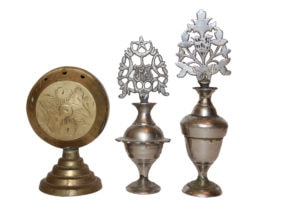
Ancient Egyptians wore makeup for different reasons including protection from gods, healing powers, and logically for the good looks.
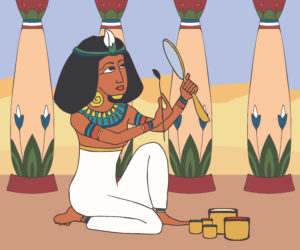
Egyptians actually invented Kohl which is eye makeup called Kohl. It was made by mixing lead and soot creating a black ointment. They also had green eye makeup by combining galena with malachite. Kohl was thought to protect the eyes from the sun and to repel flies. Egyptian high class painted their nails usually in red or black. Other colors were allowed for lower class.
Does Modern Egypt Celebrate Halloween?

Generally speaking the answer is ‘No’. However in some areas such as areas where more oriented towards tourists such as some areas in Cairo, Hurghada, and Sharm El Sheikh you may see some signs of Halloween. Some newer upper-class residential areas may also have some sort of celebrations.
Some international schools allow one day where students can go with costumes and have a party. Don’t expect a celebration similar to what happens in the western world though.
Ancient Egypt Halloween Costumes
Ancient Egyptian inspired costumes are all over the world and are very popular during Halloween season. Here are some online shopping selections from Amazon. Here is also some selections that I recommend:
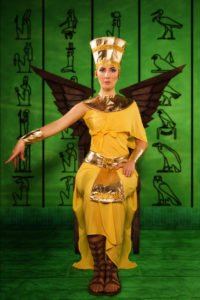
King of Egypt Costumes
Pharaoh or King of Egypt costumes come in different shapes and styles:
Adult Size – King Tut Style:
Adult Size – King of Egypt Pharaoh Style:
Adult Size – Ramses at War Style
Plus Size – Pharaoh
Kids Size – King Tut
Pharaoh – Kids Size
Egyptian Queen Costume Ideas
Egyptian Queen
Nefertari – Egyptian Queen
Egyptian Queen
Girls Size – Egyptian Queen
Cleopatra Costumes

Although Cleopatra is a Ptolemaic era queen (actually queens as many of the queens in this era were named Cleopatra). The most famous one is the last one who committed suicide after dramatic relation with Mark Antony and Roman Caesar Cleopatra VII. Roman historians depicted Cleopatra as seductive woman who used sex to lure Roman leaders, but it seems that she was far more than that. She was able to speak 7 languages and she was very talented and skilled politician and leader. She was the only ptolemaic leader to actually learn Egyptian Language.

